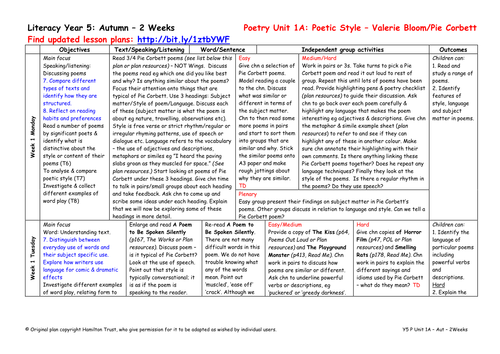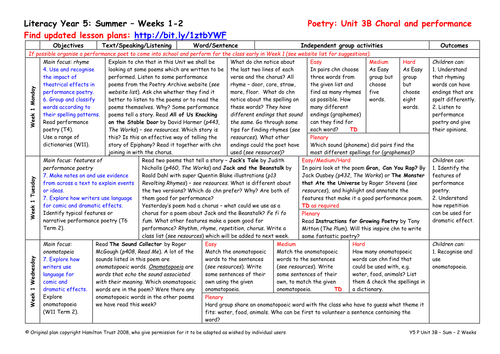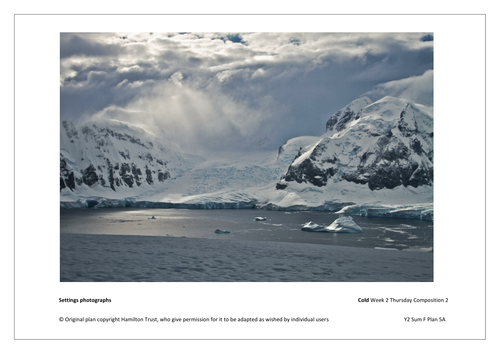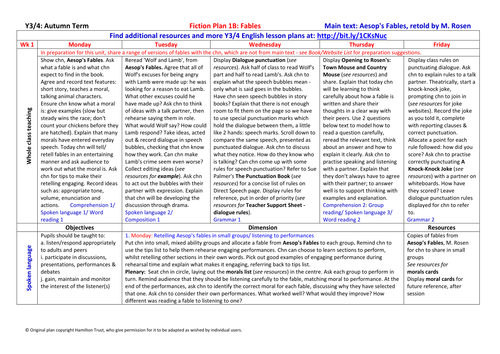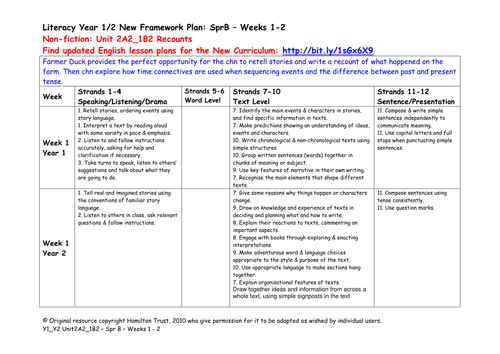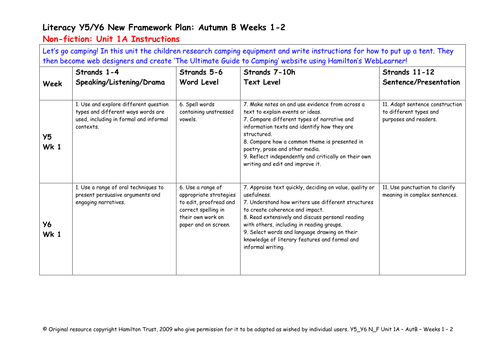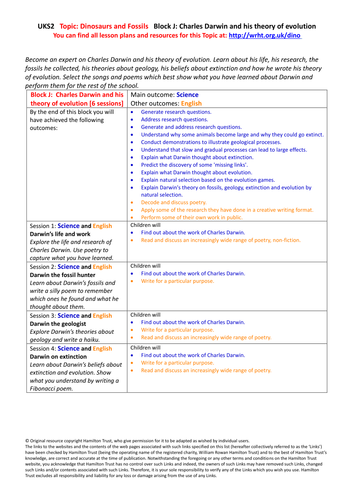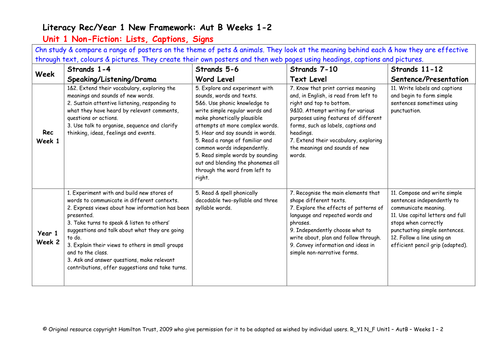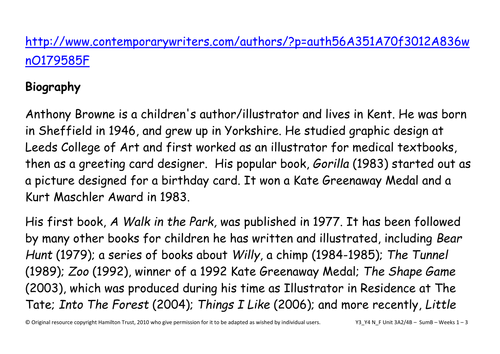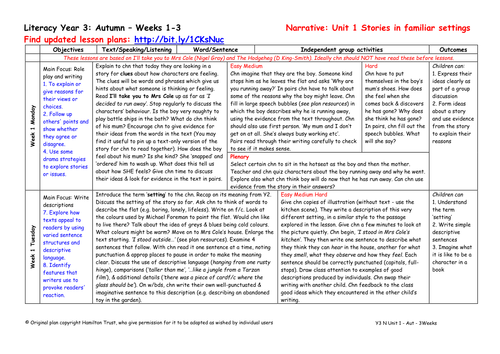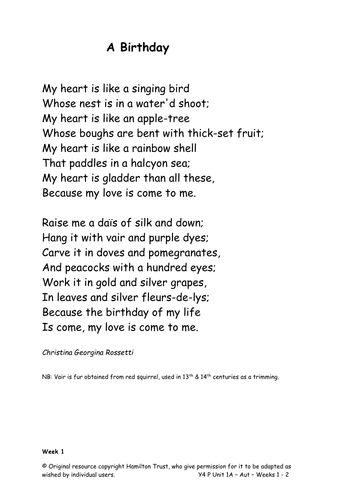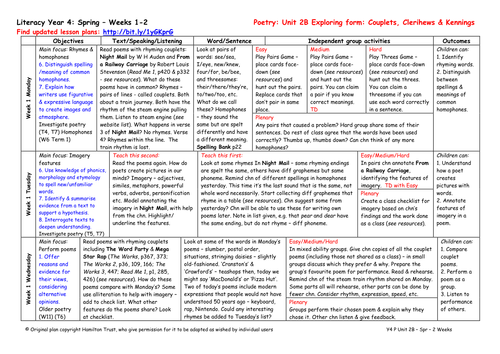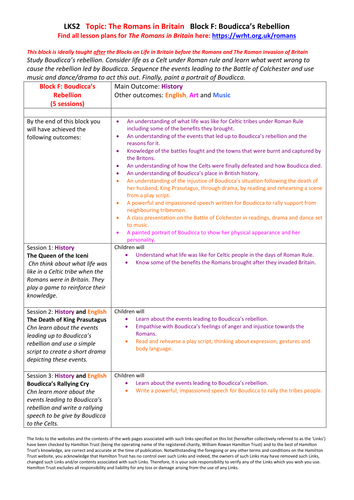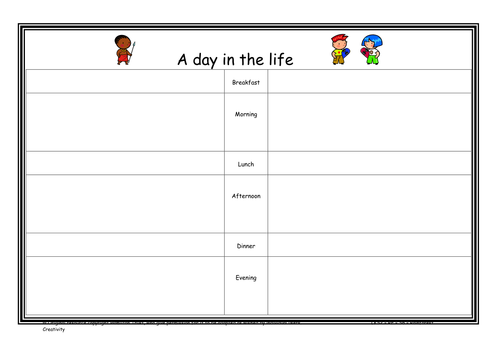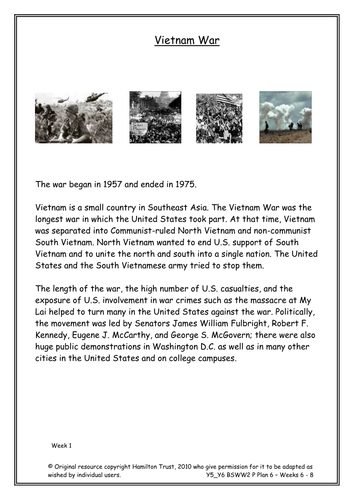
3k+Uploads
10009k+Views
11617k+Downloads
English

Yr 5 Poetry Unit 1A Poetic Style
Children have the opportunity to hear, read and respond to a range of poems from two contrasting writers. They write and perform their own free verse poems, inspired by those they have read. By adapting and borrowing elements they develop a style of their own.
Hamilton’s English planning covers all aspects of English, including SPAG, within the context of a wide range of fiction, non-fiction and poetry genres, such as traditional tales, recounts and performance poems.

Yr 5 Poetry Unit 3B Choral and performance
Compare performance poems that tell a story and identify the features that make a good performance poem. Children then write their own performance poetry based on a fairy tale. Perform it for an invited audience using dramatic conventions to enhance the poem.

Year 2 Fiction 5: Quest stories
Children read a range of quest stories, exploring structure and language choice. They explore 4 types of sentence and experiment with tense. Children write their own extended stories, concluding by performing their writing to a younger child. This plan uses the books Lost and Found and The Way Back Home, both by Oliver Jeffers and We're Going on a Bear Hunt by Michael Rosen. It also uses Hamilton Group Reader The Quest.

Year 3/4 Fiction 1: Fables
Reading a wide range of fables, including Rosen’s Aesop’s Fables, children explore dialogue through drama, debate moral messages and write letters in role.
Children write their own fables, hold a festival and try them out on a live audience. Will they win rave reviews?
Suitable for Year 3 or 4.
Hamilton’s English planning covers all aspects of English, including SPAG, within the context of a wide range of fiction, non-fiction and poetry genres, such as traditional tales, recounts and performance poems.

Yr 1/2 NF Unit 2A2-1B2 Recounts : Farmer Duck
Farmer Duck provides the perfect opportunity for the children to retell stories and write a recount of what happened on the farm. Then children explore how time connectives are used when sequencing events and the difference between past and present tense.
Find other lesson plans and resources at www.hamilton-trust.org.uk.

Yr 5/6 NF Unit 1A Instructions: Camping
Let’s go camping! In this unit the children research camping equipment and write instructions for how to put up a tent. They then become web designers and create ‘The Ultimate Guide to Camping’ website using Hamilton’s WebLearner!
Find other lesson plans and resources at www.hamilton-trust.org.uk.

Dinosaurs and Fossils - Charles Darwin and his theory of evolution - Upper Key Stage 2
Be a palaeontologist! Become an expert on Charles Darwin and his theory of evolution. Learn about his life, his research, the fossils he collected, his theories about geology, his beliefs about extinction and how he wrote his theory of evolution. Select the songs and poems which best show what you have learned about Darwin and perform them for the rest of the school.
Includes:
- Topic Overview
- Block Overview
- Lesson 01: Darwin's life and work
Explore the life and research of Charles Darwin. Use poetry to capture what you have learned.
- Lesson 02: Darwin the fossil hunter
Learn about Darwin’s fossils and write a silly poem to remember which ones he found and what he thought about them.
- Lesson 03: Darwin the geologist
Explore Darwin’s theories about geology and write a haiku.
- Lesson 04: Darwin on extinction
Learn about Darwin’s beliefs about extinction and evolution. Show what you understand by writing a Fibonacci poem.
- Lesson 05: Darwin and evolution
Explore how Darwin came up with his theory of evolution by natural selection and write a Horrible Histories style song.
- Lesson 06: Evolution performance
Select the songs and poems that best show what you have learned about Darwin. Practise and then perform them for the rest of the school.
Find more lesson plans and resources at www. hamilton-trust.org.uk.

Yr1 NF Unit 1 Lists, captions and signs
Children study and compare a range of posters on the theme of pets and animals. They look at the meaning behind each and how they are effective through text, colours and pictures. They create their own posters and then web pages using headings, captions and pictures.

Yr 3/4 NF Unit 3A2-4B Persuasive Writing: Zoos
Explore persuasive texts and writing through Anthony Browne’s book Zoo. Research the case for and against zoos and design a questionnaire.
Explore other issues about looking after animals through Michael Morpurgo’s The Dancing Bear. Debate the issues raised.
Find other lesson plans and resources at www.hamilton-trust.org.uk.

Yr 3 Poetry Unit 3B Language play: Riddles
A two week poetry unit which starts off teasing children’s brains with the riddle game from the Hobbit. Then children move on to learning favourite poems by heart, writing own riddles and creating wordplay jokes.
A guaranteed fun-filled favourite for boys!
Find other lesson plans and resources at www.hamilton-trust.org.uk.

Yr 3 Narrative Unit 1 Stories in familiar settings
Children read I’ll Take You to Mrs Cole and explore its imaginative setting. They extend this work by looking at Harry Potter and Toy Story and comparing film and written texts. Finally (optional week) children study the works of John Burningham focussing on the settings.
Hamilton’s English planning covers all aspects of English, including SPAG, within the context of a wide range of fiction, non-fiction and poetry genres, such as traditional tales, recounts and performance poems.

Yr 4 Poetry Unit 1A: Creating Images
Children use poems by Christina Rossetti to appreciate how writers use figurative and expressive language to create images and atmosphere – alliteration, similes, powerful verbs and adverbs.
Children perform one of her poems and write a poem on a similar theme.
Hamilton’s English planning covers all aspects of English, including SPAG, within the context of a wide range of fiction, non-fiction and poetry genres, such as traditional tales, recounts and performance poems.

Yr 2 Poetry Unit 3 Silly Stuff: Language Play
Children read, learn and perform examples of tongue twisters and nursery rhymes. They tackle riddles and create their own based on the examples. They enjoy nonsense poems and appreciate how punctuation helps reading aloud, before creating a class poetry book.
Find other lesson plans and resources at www.hamilton-trust.org.uk.

Yr 4 Poetry Unit 2B Exploring form
Look at the structure of Couplets, Clerihews and Kennings. Practise techniques for finding rhymes. Investigate homophones including words that are commonly confused. Children write poems in the different forms for written or spoken publication.
Find other lesson plans and resources at www.hamilton-trust.org.uk.

Boudicca's rebellion
Children study Boudicca’s rebellion.
They consider life as a Celt under Roman rule and learn what went wrong to cause the rebellion led by Boudicca. They sequence the events leading to the Battle of Colchester and use music and dance/drama to act this out. Finally they paint a portrait of Boudicca.
Includes:
- Topic Overview
- Block Overview
- Lesson 01: The Queen of the Iceni
Children think about what life was like in a Celtic tribe when the Romans were in Britain. They play a game to reinforce their knowledge.
- Lesson 02: The death of King Prasutagus
Children learn about the events leading up to Boudicca’s rebellion and use a simple script to create a short drama depicting these events.
- Lesson 03: Boudicca’s rallying cry
Children learn more about the events leading to Boudicca’s rebellion and write a rallying speech to be give by Boudicca to the Celts.
- Lesson 04: The Battle of Colchester
Children learn about the battles fought between Boudicca and the Romans. Using soundtrack of Mornay’s dream, they perform a dance/drama of the Battle of Colchester.
- Lesson 05: The story ends and the legend begins
Children learn how Boudicaa’s rebellion ended and create a portrait of Boudicca showing her character as a warrior and a proud leader of her tribe’s people.
This block is part of our Key Stage 2 Cross-Curricular Topic The Romans in Britain.

A day in the life! Rainforest Diaries
Your lunch is what you find to eat in the rainforest, not the contents of mum’s packed lunch! But there are other important differences too!
Children use their notes from the previous session to compare their lives to those of children in the Jungle.

Yr 4 Narrative Unit 5 Plays
Use proverbs to stimulate creation of some short plays based on everyday life. Children then look closely at playscript features and stage directions to develop characters and setting. Finally children create scenes based on events in their favourite Roald Dahl books.
Find other lesson plans and resources at www.hamilton-trust.org.uk.

Song lyrics Weeks 6 - 8
This unit is all about having fun with iconic song lyrics!
Children will explore underlying themes and influences in key songs by the Beetles and Bob Dylan before composing their own song lyrics about current issues that are important to them.

Yr 6 Poetry Unit H1 Lewis Carroll nonsense poems
Carroll’s Walrus and the Carpenter sets off this stimulating unit which takes in several of his nonsense poems, including Jabberwocky which children re-write in standard English! His position as an iconic figure in English literature is debated.
Find other lesson plans and resources at www.hamilton-trust.org.uk.

